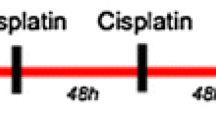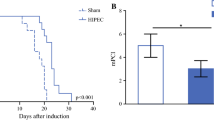Abstract
Background: Peritoneal carcinomatosis is a difficult management problem, and intraperitoneal treatment approaches may provide an opportunity to intensify dose and minimize toxicity. The current experiments were conducted to characterize the cytotoxic effects of cisplatin (cDDP), tumor necrosis factor (TNF), and hyperthermia (HT) on a gastric cancer cell line in vitro under conditions achievable with intraperitoneal treatment.
Methods: Seoul National University gastric cancer cell line (SNU-5), a poorly differentiated gastric cancer cell line, was tested for sensitivity to various doses of cDDP, TNF, or combinations of the two at normothermia (37°C) or HT (42.5°C). The effect of TNF on cellular rates of cDDP accumulation, efflux, and cDDP-DNA adduct formation were evaluated using atomic absorbance spectrometry with Zeemen background correction.
Results: During a 2-h exposure to various doses of cDDP with HT, we observed a supraadditive cytotoxicity of SNU-5 with 1 to 50 µg/ml of TNF (p2=0.0001). In the presence of the three-agent combination (HT, TNF, and cDDP) we observed statistically significant increases in total cellular accumulation of cisplatin (p2=0.016); a nonsignificant decrease in cellular efflux of drug (p2=0.098); and a 40% increase in persistent cisplatin DNA damage as measured by atomic absorption spectrophotometry (p2=0.06). These patterns were specifically not seen with the combinations of cDDP and HT, or cDDP and TNF.
Conclusions: These data provide the experimental basis for the use of TNF and cDDP with HT in the treatment of gastric cancer and support the investigation of these agents in vivo in the regional treatment of peritoneal carcinomatosis.
Similar content being viewed by others
References
Fujimoto S, Shgrestha RD, Kokubun M, et al. Intraperitoneal hyperthermic perfusion combined with surgery effective for gastric cancer patients with peritoneal seeding.Ann Surg 1988;208:36–41.
Fujimoto S, Shrestha RD, Kokuban M, et al. Positive results of combined therapy of surgery and intraperitoneal hyperthermic perfusion for far-advanced gastric cancer.Ann Surg 1990;212:592–6.
Fujimoto S, Shrestha RD, Kokubun M, et al. Clinical trial with surgery and intraperitoneal hyperthermic perfusion for peritoneal recurrence of gastrointestinal cancer.Cancer 1989;64:154–60.
Koga S, Hamazoe R, Maeta M, Shimizu N, Murakami A, Wakatsuki T. Prophylactic therapy for peritoneal recurrence of gastric cancer by continuous hyperthermic peritoneal perfusion with mitomycin C.Cancer 1988;61:232–7.
Alexander HR, Buell JF, Fraker DL. Rationale and clinical status of continuous hyperthermic peritoneal perfusion for the treatment of peritoneal carcinomatosis. In: DeVita VT Jr, Hellman S, Rosenberg SA, eds.Principles and practice of oncology: PPO updates. Philadelphia: JB Lippincott, 1995:1–9.
Barlogie B, Corry PM, Drewinko B. In vitro thermochemotherapy of human colon cancer cells with cis-dichlorodiammineplatinum(II) and Mitomycin C.Cancer Res 1980;40:1165–8.
Yamaguchi A, Tsukioka Y, Fushida S, et al. Intraperitoneal hyperthermic treatment for peritoneal dissemination of colorectal cancers.Dis Colon Rectum 1992;35:964–8.
Fujimura T, Yonemura Y, Muraoka K, et al. Continuous hyperthermic peritoneal perfusion for the prevention of peritoneal recurrence of gastric cancer: randomized controlled study.World J Surg 1994;18:150–5.
Hamazoe R, Maeta M, Kaibara N. Intraperitoneal thermochemotherapy for prevention of peritoneal recurrence of gastric cancer.Cancer 1994;73:2048–52.
Fujimura T, Yonemura Y, Fushida S, et al. Continuous hyperthermic peritoneal perfusion for the treatment of peritoneal dissemination in gastric cancers and subsequent second-look operation.Cancer 1990;65:65–71.
Leinard D, Lejeune F, Delmotte J, et al. High doses of rTNFα in combination with IFN-gamma and melphalan in isolation perfusion of the limbs for melanoma and sarcoma.J Clin Oncol 1992;10:52–60.
Fraker DL, Alexander HR. Isolated limb perfusion with high-dose tumor necrosis factor for extremity melanoma and sarcoma. In: DeVita VT, Hellman S, Rosenberg SA, eds.Important advances in oncology. Philadelphia: JB Lippincott, 1994:179–92.
Fraker DL, Alexander HR. The use of tumor necrosis factor in isolated limb perfusions for melanoma and sarcoma. In: DeVita V, Hellman S, Rosenberg SA, eds.Principles and practice of oncology. Philadelphia: JB Lippincott, 1993.
Räth U, Kaufmann M, Schmid H, et al. Effect of intraperitoneal recombinant human tumour necrosis factor alpha on malignant ascites.Eur J Cancer 1991;27:121–5.
Hardy J, Jones A, Gore ME, Viner C, Selby P, Wiltshaw E. Treatment of advanced ovarian cancer with intraperitoneal tumour necrosis factor.Eur J Cancer 1990;26:771.
Fraker DL, Alexander HR, Pass HI. Biologic therapy with TNF: systemic administration and isolation-perfusion. In: DeVita V, Hellman S, Rosenberg SA, eds.Biologic therapy of cancer. Philadelphia: JB Lippincott, 1995:329–45.
Markman M, Reichman B, Ianotti N, et al. Phase I trial of recombinant tumor necrosis factor administered by the intraperitoneal route.Reg Cancer Treat 1989;2:174–7.
Raeth U, Schmid H, Karck U, Kempeni J, Schlick E, Kaufmann M. Phase II trial of recombinant human tumor necrosis factorα (rHuTNF) in patients with malignant ascites from ovarian carcinomas and non-ovarian tumors with intraperitoneal spread.Proc ASCO 1991;10:187.
Yamauchi N, Watanabe N, Maeda M, et al. Mechanism of synergistic cytotoxic effect between tumor necrosis factor and hyperthermia.Jpn J Cancer Res 1992;83:540–5.
Klostergaard J, Leroux E, Siddik ZH, Khodadadian M, Tomasovic SP. Enhanced sensitivity of human colon tumor cell lines in vitro in response to thermochemoimmunotherapy.Cancer Res 1992;52:5271–7.
Flessner MF, Dedrick RL. Intraperitoneal chemotherapy. In: Gokal R, Nolph KD, eds.The textbook of peritoneal dialysis. The Netherlands: Kluwer Academic, 1994:769–89.
Markman M. Intraperitoneal chemotherapy for malignant diseases of the gastrointestinal tract.Surg Gynecol Obstet 1987;164:89–93.
Barloie B, Corry PM, Drewinko B. In vitro thermotherapy of colon cancer cells with cis-dischlorodiammineplatinum(II) and mitomycin C.Chem Biol Interact 1987;61:1.
Herman TS, Teicher BA, Cathcart KNS, Kaufman ME, Lee JB, Lee MN. Effect of hyperthermia on cis-diamminedichlorplatinum(II), (rhodamine123)2[tetrachloroplatinum(II)], in a human squamous cell carcinoma line and cis-diamminedichloroplatinum(II)-resistant subline.Cancer Res 1988;48:5101.
Overgaard J, Radacic MM, Gran C. Interaction of hyperthermia and cis-diamminedichloroplatinum(II) alone or combined with radiation in a C3H mammary carcinoma in vivo.Cancer Res 1991;51:707.
Alberts DS, Peng YM, Chen G, Moon TE, Cetas TC, Hoeschele JD. Therapeutic synergism of hyperthermia-cisplatinum in a mouse model.J Natl Cancer Inst 1980;65:455.
Wondergem J, Bulger RE, Strebel FR, et al. Effect of cis-diamminedichloroplatinum(II) combined with whole body hyperthermia on renal injury.Cancer Res 1988;48:440–6.
Ohno S, Siddik ZH, Kido Y, Zwelling LA, Bull JM. Thermal enhancement of drug uptake and DNA adducts as a possible mechanism for the effect of sequencing hyperthermia on cis-platin-induced cytotoxicity in L1210 cells.Cancer Chemother Pharmacol 1994;34:302–6.
Reed E, Parker RJ, Gill I, et al. Platinum-DNA adduct in leukocyte DNA of a chohort of 49 patients with 24 different types of malignancies.Cancer Res 1993;53:3694–9.
McGahan MC, Tyczkowska K. The determination of platinum in biological materials by electrothermal atomic absorption spectroscopy.Spectrochim Acta 1987;42B:665–8.
Flamm WG, Birnstiel ML, Walker PMB.Subcellular components: preparation and fractionation. London: Butterworth, 1969.
Reed E, Sauerhoff S, Poirier MC. Quantitation of platinum-DNA binding in human tissues following therapeutic levels of drug exposure.Atomic Spectroscopy 1988;9:93–5.
Hahn GM. Metabolic aspects of the role of hyperthermia in mammalian cell inactivation and their possible relevance to cancer treatment.Cancer Res 1974;34:3117–23.
Dudar TE, Jain RK. Differential response of normal and tumor microcirculation to hyperthermia.Cancer Res 1984;44:605–12.
Joiner MC, Steel GG, Stephens TC. Response of two mouse tumours to hyperthermia with CCNU or melphalan.Br J Cancer 1982;45:17–26.
Kitamura K, Kuwano H, Matsuda H, Toh Y, Masuda H, Sugimachi K. Synergistic effects of intratumor administration of cis-diamminedichloroplatinum(II) combined with local hyperthermia in melanoma bearing mice.J Surg Oncol 1992;51:188–94.
Ohno S, Strebetl FR, Stephens C, et al. Increased therapeutic efficacy induced by tumor necrosis factor α combined with platinum complexes and whole-body hyperthermia in rats.Cancer Res 1992;52:4096–101.
Los G, Sminia P, Wondergem J, et al. Optimisation of intraperitoneal cisplatin therapy with regional hyperthermia in rats.Eur J Cancer 1991;4:472–7.
Bonavida B: TNF as immunomodulatory agent.Immunol Series 1992;56:315–29.
Parker RJ, Eastman A, Bostick-Burton F, Reed E. Acquired cisplatin resistance in human ovarian cancer cells is associated with enhanced repair of cisplatin-DNA lesions and reduced drug accumulation.J Clin Invest 1991;87:772–7.
Howell SB, Pfeifle CE, Wung WE, Olshen RA. Intraperitoneal cis-diamminedichloroplatinum with systemic thiosulfate protection.Cancer Res 1983;43:1426–31.
Alberts DS, Liu PY, Hannigan EV, et al. Phase III study of intraperitoneal (IP) cisplatin (CDDP)/intravenous (IV) cyclophosphamide (CPA) vs IV CDDP/IV CPA in patients (PTS) with optimal disease stage III ovarian cancer: a SWOG-GOG-ECOG intergroup study (INT 0051) [Abstract].Am Soc Clin Oncol 1995;14:273.
Zakris EL, Dewhirst MW, Riviere JE, Hoopes PJ, Page RL, Oleson JR. Pharmacokinetics and toxicity of intraperitoneal cisplatin combined with regional hyperthermia.J Clin Oncol 1987;5:1613–20.
Raeth U, Schmid H, Hofmann J, et al. Intraperitoneal (i.p.) application of recombinant human tumor necrosis factor (rHuTNF) as an effective palliative treatment of malignant ascites from ovarian and gastroenteropancreatic carcinomas.Proc ASCO 1989;8:181.
Author information
Authors and Affiliations
Rights and permissions
About this article
Cite this article
Buell, J.F., Reed, E., Lee, K.B. et al. Synergistic effect and possible mechanisms of tumor necrosis factor and cisplatin cytotoxicity under moderate hyperthermia against gastric cancer cells. Annals of Surgical Oncology 4, 141–148 (1997). https://doi.org/10.1007/BF02303797
Received:
Accepted:
Issue Date:
DOI: https://doi.org/10.1007/BF02303797




